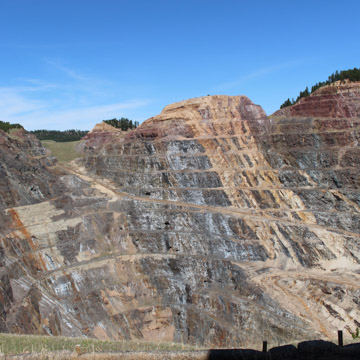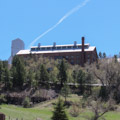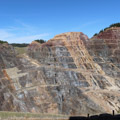You are here
Sanford Underground Research Facility
The deepest underground scientific laboratory in the United States is the Sanford Underground Research Facility (Sanford Lab), located in the former Homestake gold mine in Lead, South Dakota. The Sanford Lab occupies 223 surface acres and 7,700 underground acres.
The Homestake claim was established during the 1876 Black Hills Gold Rush. Moses and Fred Manuel extracted more than $5,000 worth of gold in their first year. Politician and businessman George Hearst (father of William Randolph Hearst) purchased the Manuel brothers’ claim the next year and expanded it to include more than 8,000 acres of patented claims, an 8,000-foot-deep underground mine, and a 1,000-foot-deep surface mine known as the Open Cut. The operation established its own railroad in 1880, purchased its first electrical generator in 1888, and constructed its own power plant by 1912. By 1932 the mine began operating a new treatment plant, and two years later opened the Ross Shaft, with a hoist system over one mile deep. The Yates Shaft opened in 1941 and reached the 4,850-foot level in 1954. Surface mining was abandoned between 1941 and 1983, but was then reactivated until 1998. The mining operation eventually became the largest gold mine in the Western hemisphere and was the oldest continuously operating gold mine in the world when operations ceased in 2001.
The site’s depth and rock stability provide what scientists call a near-perfect environment for experiments that need to escape cosmic radiation that can interfere with the detection of rare physics events. Nuclear chemist Raymond Davis Jr. had built a solar neutrino observatory in the mine in the mid-1960s, and his groundbreaking research earned him the 2002 Nobel Prize in Physics. Five years after the mine closed, the company donated the property to South Dakota for use as an underground laboratory. With funding from a number of resources, including philanthropist T. Denny Sanford, the laboratory has gained international attention. The first two major experiments at the Sanford Lab were the Large Underground Xenon (LUX) dark matter experiment (2013–2016), which was the most sensitive dark matter detector in the world, and the ongoing Majorana Demonstrator Project, which explores the imbalance of matter and antimatter in the universe. Additional projects and experiments began in 2015.
Of the over 370 miles of shafts, drifts, and ramps carved out for the Homestake mine, the Sanford Lab maintains about 12 miles for its activities. Many of the buildings and structures associated with the mining operation have been demolished except for several that were rehabilitated for use at the laboratory. Surface-level facilities include a 780,000-square-foot laboratory with a cleanroom that allows researchers to clean and assemble parts of their experiments before transporting them underground; a wastewater treatment plant necessary for keeping naturally infiltrating water from accumulating underground; and a visitor center located at the edge of the Open Cut—the low building features a varied and angular roofline that evokes the strata of the mined earth directly behind it.
The surface property comprises both the Ross and Yates campuses, named for the respective shafts used to access the underground labs. In 2012, the Yates Shaft opened as the 5,000-foot-deep lifeline for the research facility. Everything transported underground—equipment, supplies, and the researchers themselves—moves through the Yates Shaft, whose hoists have been in operation since 1939. The underground Davis Campus, the site where Davis conducted his solar neutrino experiment, opened in 2012. Located nearly a mile underground, the laboratory is similar to those aboveground (white walls, bright lighting, and modern technology) but without windows. Instead, the facility provides clean filtered air since even a speck of dust could ruin the experiment results. The laboratory includes a 72,000-gallon water tank that serves as additional shielding from cosmic radiation, a water-deionization system, cleanroom, and control room.
In 2017 crews completed a five-year project of refurbishing the Ross Shaft into a 4,850-foot-deep structure that will be critical in supporting construction of the Long-Baseline Neutrino Facility (LBNF). The facility will house the international Deep Underground Neutrino Experiment (DUNE), the largest experiment ever built in the United States to study the properties of neutrinos; it will be built and operated by more than 1,000 scientists and engineers from 31 countries.
Education is an essential part of the Sanford Lab. Black Hills State University manages an underground campus that houses a class-1,000 cleanroom containing five ultra-sensitive low-background counters used to assay materials for ultra-sensitive experiments, in addition to workspace available to graduate and undergraduate researchers in a variety of disciplines. The counters are available to other universities and partners, although it is managed locally by university faculty.
The Sanford Lab is not open to the public for general tours but offers seasonal trolley tours of the surface campus and guided visits of the Yates Shaft Hoistroom.
References
Writing Credits
If SAH Archipedia has been useful to you, please consider supporting it.
SAH Archipedia tells the story of the United States through its buildings, landscapes, and cities. This freely available resource empowers the public with authoritative knowledge that deepens their understanding and appreciation of the built environment. But the Society of Architectural Historians, which created SAH Archipedia with University of Virginia Press, needs your support to maintain the high-caliber research, writing, photography, cartography, editing, design, and programming that make SAH Archipedia a trusted online resource available to all who value the history of place, heritage tourism, and learning.

















